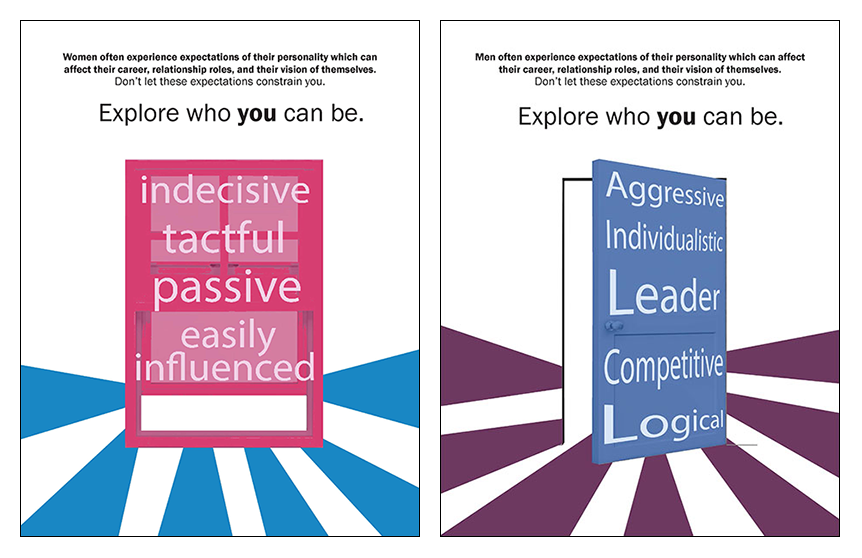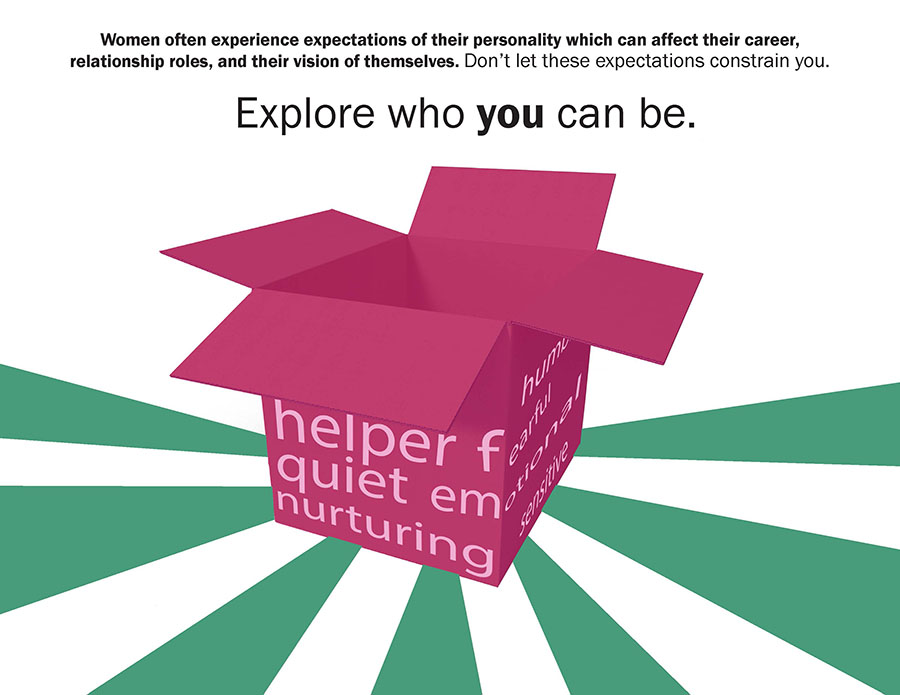By: Beth Keenan
Influencing the thoughts, actions, and behaviors of others may seem difficult if not impossible, but such is the goal of propaganda and of this poster campaign, which is a form of propaganda in and of itself. In the class COMM-3325, propaganda is defined as a systematic (continual and strategic) sending of self-interested messages (messages favoring the party sending them) in order to alter the attitude of their audience.
In this case, four posters were prepared with a message challenging gender expectations in terms of personality, with the goal of making people explore their own personality and questions judgements they’ve made about ‘appropriate’ personality traits based on gender. The creative choices were simple in order to make the message and images easy to understand. The target audience of these posters is working adults, between the ages of 18 and 34, when they could still be forming key relationships and making career decisions, both of which are deeply influenced by their personality, goals, and their visions of themselves.

The specific objective of these posters is to encourage young people to question gender expectations in terms of personality and to explore who they are as a result. This is crucial to allowing people to live up their full potential without being trapped by beliefs about how they should act based on whether they are a man or a woman. For example, men and women in contemporary society face expectations in terms of leadership. Men are expected to lead, strategize, and voice their opinions, whereas women are expected to listen, harmonize the group, and help the ‘leader’. These beliefs inevitably pressure men into acting in a possibly dominant manner, when they may have a truly nurturing personality, and they may inhibit women from taking charge and leading.
Essentially, society prizes very specific personality traits for both men and women. This poster campaign aims to have audiences question this and explore their own unique personality, even if it does not meet archaic societal expectations.

The creative choices in this poster campaign align with traditional techniques in propaganda. Leonard Doob explains in “Goebbel’s Principles of Propaganda” (1950) that propaganda must be “capable of being easily learned” (p. 436) following “a principle of simplification” (p. 436)[1]. These four posters are simple in their design and therefore relatively easy to understand, and if the images are not clear enough, there is a title and subtitle which further explain the message.
Each poster includes an image, either pink or blue, representing either women (pink) or men (blue), since these two colors are stereotypically associated with a certain gender in contemporary society. The images are enclosed spaces or objects which are open or are opening up on each poster and on the object itself there are words; these words are personality traits stereotypically associated with the gender of the object (blue or pink, men or women). These colors are easy to understand, and the images, while they are metaphorical, are also simple in their design.
The four posters include an open box (pink), a window (pink), a door (blue), and a brain (blue), with rays of color pointing to the images, which brings attention to them. There are two posters for men, and two for women, following the concept of equal treatment and importance. If the colors are not clear enough, in the subtitle of the pieces it directly states the word “women” or “men” depending on the poster. The subtitle reads “(Men or Women) often experience expectations of their personality which can affect their career, relationship roles, and their vision of themselves. Don’t let these expectations constrain you.” The title below reads “Explore who you can be”. This “Explore who you can be” is the call to action. Each poster includes similar elements (subtitle, title, colors, etc.) in order to maintain a sense of unity between the four. The creative decisions which underpin this poster hearken back to traditional ideals of propaganda in order to maximize their potential of changing the audience’s thoughts and behaviors.

These posters would be placed in places which people continually visit, so their message would be continually delivered to the intended audience. Ellul (1973) emphasizes the importance of this continuity to changing people’s behaviors[2]. If the attitudes toward certain personality traits did change, hopefully this would enable men and women to live their lives more freely and pursue their goals without judgement from others.
[1] Doob, Leonard. (1950). Goebbel’s Principles of Propaganda. Public Opinion Quarterly, 14 (3), 419-442.
[2] Ellul, J. (1973). Propaganda: The Formation of Men’s Attitudes. New York, NY: Random House.